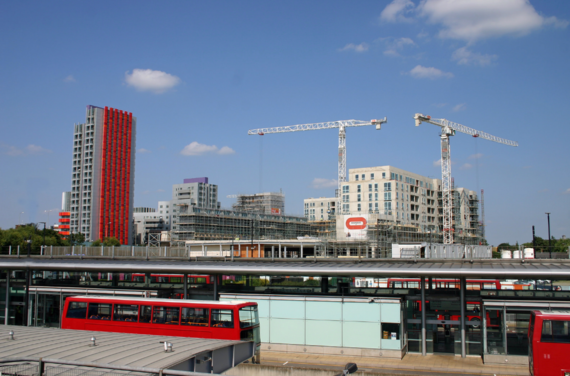
Our Early Action Task Force has worked with the Welsh government on the development of their Future Generations Bill. In the course of this work we have spoken to young people in North Wales. Over and over again their stories have begun "we live in an area that used to have coal mines...". Inquire a little further and you discover that the speaker doesn't remember the mine - it closed before they were born - but the local story has never moved on.
Begin a similar conversation in east London and you will seldom hear young people say "this is an area that used to have docks", although, of course, dock work was once as significant in Newham as mining in Wales. The east London economy has changed and thrown up a new set of openings and opportunities for the rising generation. The change hasn't always been positive. Half the workforce in Newham is paid below the London Living Wage and more than one in five less than the minimum wage, but the story has moved on and continues to move on rapidly and relentlessly.
One in every five of our community leaves each year. Many, perhaps for good reasons, they have trained hard and secured stable employment. They can plan for the future and are ready to settle. They move out of the borough, usually further east towards Redbridge, Havering and Essex, as generations of migrants have done before them.
Others move for the opposite reason. Their financial circumstances are uncertain, possibly short-term contracts on very low wages, possibly periods of unemployment, their accommodation is inevitably affected. They can't put down roots and they move from short-term let to short-term let sometimes in Newham, sometimes beyond.
Both groups are replaced by vulnerable people from across the world and the cycle begins again. This perpetual churn means that Newham features continuously in the various league tables measuring poverty, ill-health and social exclusion. Its easy then to look at Community Links and conclude that, if this is still one of the poorest areas in the UK, we have been busy doing nothing these last 30 years or so. That is to confuse the people and the place. Lives have been changed but, for the most part, the territory has not.
Passenger and cargo ships no longer berth at the docks, yet east London is still one of a small number of places in the UK that attract new waves of people who are likely to be disproportionately poor and, initially at least, ill-equipped to flourish. Few of our new arrivals have qualifications which are recognised in the UK. The 2014 Newham Household Panel Survey showed that 36% of the population here have no recognised qualifications - double the London average.
This does not mean Newham residents aren't "hard working families playing by the rules". On the contrary, many work very hard, often on more than one job, but for very low rates of pay. More than 50% of the workforce here earns below the London Living wage and over 20% are illegally employed on less than the minimum wage. The fact that social indices in an area remain stubbornly static does not necessarily indicate that social programmes have failed. It might do, but it equally might not. We need to invest more in longitudinal studies that follow the person, rather than remain on the patch, if we want to better understand the value of neighbourhood-based work in communities like east London.
Westfield shopping centre and surrounding developments, although famous internationally, are actually responsible for only about 20% of the current investment in physical regeneration in east London. This large-scale investment and development makes us hopeful. It shapes perceptions and ambitions and throws up the opportunities that are so evidently absent in north Wales - but it is not inevitably and automatically a good thing: The Canary Wharf development on the Isle of Dogs has been a very big part of the east London story over the last 30 years. Yet changes in the physical landscape are not a reliable proxy for changing people's lives. The promised "trickle down" from Canary Wharf never reached the ground but at this relatively early stage we think that the Olympic developments, and certainly Westfield, are creating jobs, homes and opportunities which offer real potential for social as well as physical regeneration. At the very least they help to change the story and so lift aspirations. No young person here would describe Stratford as "the place that used to have the biggest railway goods yard in Britain".
Parts of this area, which less than a generation ago was one of the poorest regions in Western Europe, now has some of the highest land values in the world; of course, they are not occupied by the same families. Poverty hasn't been eliminated or even reduced. It has been relocated.
The large housing estate opposite the Community Links centre on Barking Road is being redeveloped now. This will be the third time that the estate has been knocked down and rebuilt since the slum clearance programme in the 1950s and early 1960s. Previous programmes, particularly the tower block phase, which Community Links campaigned so vigorously around in the 1980s, entrenched the poverty here and exacerbated the social exclusion.
On both the Canning Town Estate and the Isle of Dogs massive public investment in buildings, albeit in very different kinds of building, has largely failed to secure material improvement in people's lives. Yet there are still few social programmes running alongside the enormous physical regeneration. This is no longer just about poor incomers - it is equally as important to link the new better-off families who have moved to the Olympic Park with their neighbours if the legacy is to be achieved for all.
This is an extract from the Community Links publication Revisiting Out of the Ordinary: Learning the lessons about doing things differently to grow strong neighbourhoods; the book is the second in a series began in 2010 outlining our approach to local social regeneration. Using case studies and data, and drawing on the 37 years of experience of Community Links' staff, service users and partners, Out of the Ordinary demonstrates the positive impact and extraordinary things that ordinary people can make possible. This second volume explores how Community Links has adapted to the significant external changes, both local and national, in the four years since 2010. The book is available here .
